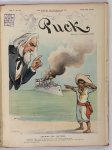
Following the wars for independence in Latin America in the early 1800s, the United States feared further European influence in the new “power vacuum.” Latin American political structures during this time were similar to a vacuum in that once independence was gained, there were no strong leadership to replace the old ones. The United States saw this as an opportunity to gain more influence in the region. In 1823, US President James Monroe created the Monroe Doctrine that stated that any European attempts to gain control of Latin America would be seen as an act of aggression against the United States. As a result, the United States began to see itself as a protector of Latin America. The US saw this power vacuum as an opportunity to gain an advantage over Europe.
The image depicts a German ship aggressively approaching the Venezuelan shore. Because the arrival of the ship indicates European imperialism that the region spent so long trying to overthrow, the image shows a boy crying on the shore while a large, Caucasian man talks to him. The way the boy is portrayed is problematic and racist due to several stereotypes. The boy is shown wearing very stereotypical clothes of the region. The traditional hat labeled “Venezuela” along with the plain white shirt and pants with a cloth wrapped around his neck indicate a primitive or undignified nature. In addition, the boy is depicted as young and small as if he is unable to take care of himself. This is reflective of how the United States and Europe viewed Latin America at the time as weak and dependent on outside help. In contrast, the man talking to the boy is clearly an adult of the upper class. He is telling the boy not to fear the German boat because the United States would protect him, but he needs to continue paying his debts. This image highlights larger racial issues of the time. The United States and Europe viewed Latin America as a region that needed constant attention. The white elites believed that they could control the region while maximizing their own profits without considering the long-term impact they would eventually leave.
Works Cited:
Puck, v. 50, no. 1299 (1902 January 22), cover.
